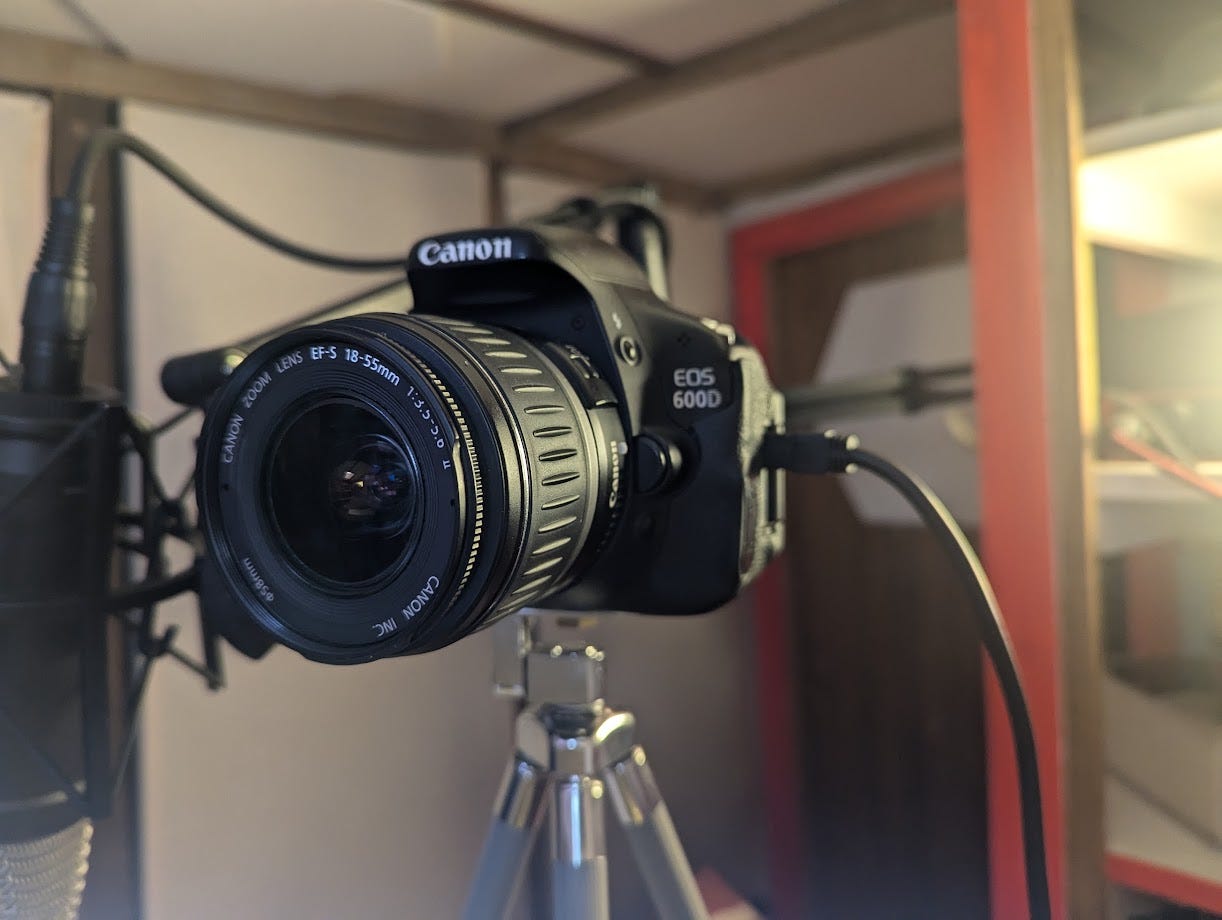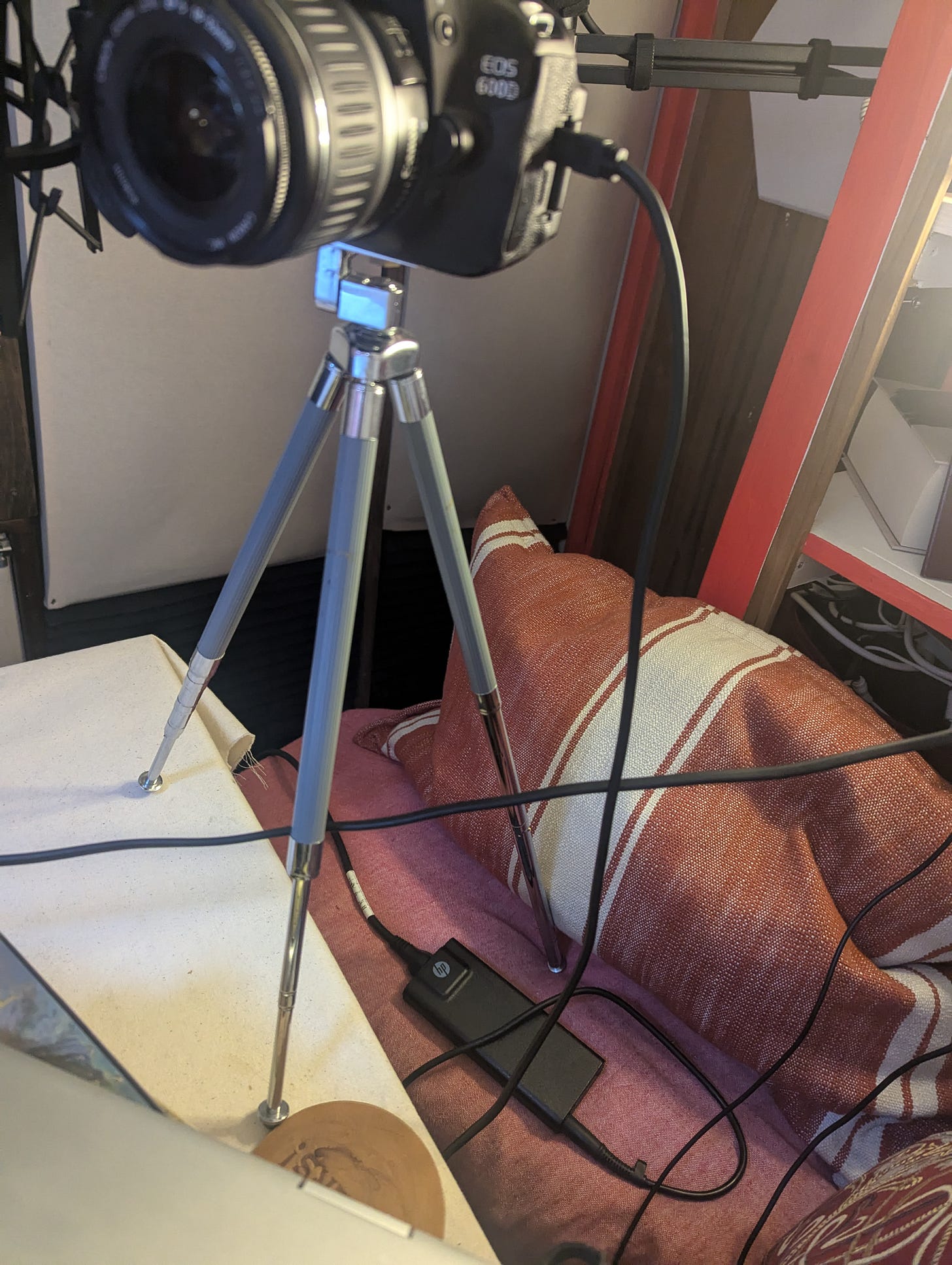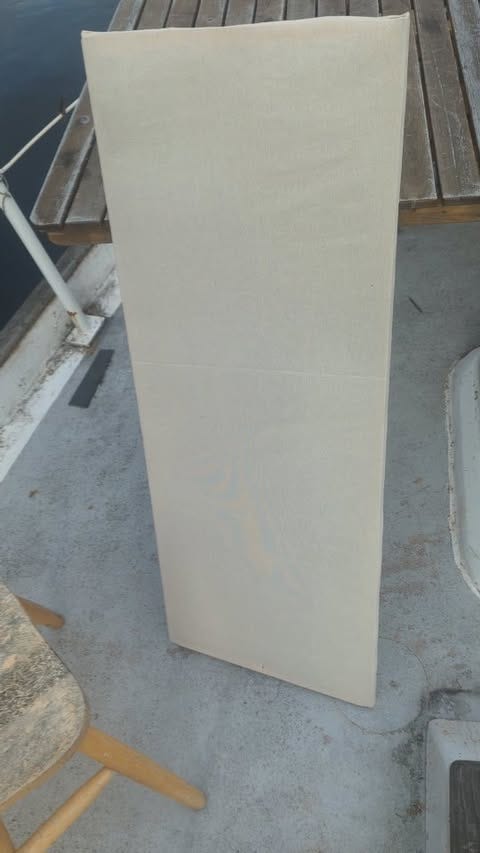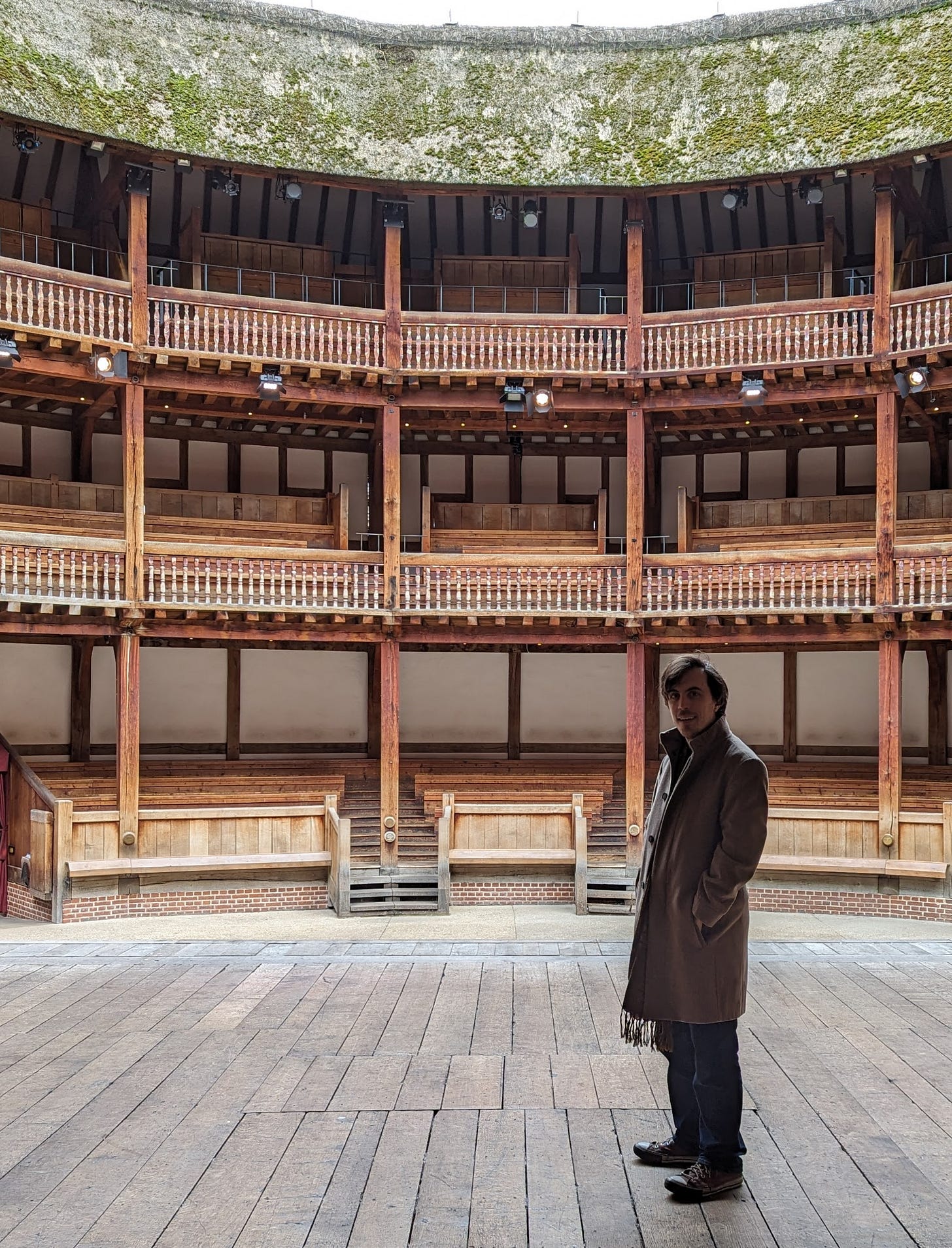
If you’re starting out as an actor, there’s a wealth of advice on what exactly you need. Headshots. Spotlight and/or Actors Access. Some sort approach to scripts that goes beyond ‘highlight and hope’. But the longer we stay in the job, the murkier it gets. There can be an impression that crossing the threshold into professionalism is the final rung on the ladder. It’s not. It’s the first one, and the only one that’s not been painted with an invisibility brush.
Many of the conversations I have with other actors about the industry revolve around the little extra things we can do, or are trying out, and those are the ones that, to be honest, sparked this newsletter. Experiments in the fog.
So, in an effort to keep a minimum of gates, here are the things I can think of that I spent money on this year that have offered a material improvement to my acting, and why.
A Proper Camera
DSLRs have been with us for long enough that you can now find old but good ones second hand at not crazy prices. I wanted one. I wanted to be able to use it a) for self-tapes and b) as a webcam. Most of my auditions since the pandemic have been over Zoom and I want more control over how I present myself to potential employers than I’m offered by the standard Windows settings1.
I bought a second hand Canon EOS 600D from 2011 with battery and charger but without lens from mpb.com for about £75. I bought a lens that fit it at CEX for £30. I can also recommend the Oxfam website which has regular good photography deals.
Why has this helped?
Until now, if I needed to film myself it was a question of getting my phone set up just so in a process that spent as much time in set-up as it did actual filming. Then if I wanted to review a take, I would go to the phone, attempt to rewatch it without knocking things out place, fail, swear a lot, and reset.
But my camera lives in my office. It is permanently set up. With it plugged into my laptop, I can film myself from the default Windows Camera app, immediately review, delete, and try again.
The result is, I’m a little startled to say, better acting. By getting immediate feedback on what I’m doing, the thoughts become more obvious, the story becomes easier to understand, and any line that isn’t properly connected shows up on my screen like a flashing red light. If the scene is tricky, I’ll film it little bit by little bit as I work through it, sometimes 20-30sec chunks at a time, then start to thread it all together.
Related peripherals I bought:
A mini-USB (that’s the small but chunky looking one) to USB-C cable - good buy, I use it every day.
A dummy battery so I can keep the camera plugged in - terrible buy, the dummy battery does not work. So I currently recharge the supplied battery if I use the camera continuously for more than about two hours. This is not the worst but worth improving on next year.
A vintage tripod - hold on, this deserves its own entry.
A Vintage Tripod
Fun fact: those little screws on a tripod have been standardized for a while now. I used to have a modern camera tripod, made of plastic, very lightweight… it broke. So I looked at alternatives. Modern tripods are expensive. And if you don’t want them to break, more expensive.
Casting around for ideas, I hit up Etsy, typed in ‘tripod’ and clicked the Vintage checkbox.
I found a Japanese one with its own carrier case from the 1960s, mostly made of aluminium with a nice leather top. It folds down to about the size of a small school ruler.
Why it helps:
It folds up small enough to stand on my desk or can telescope to sit on the floor. Whether I’m working on a scene sat down or stood up, I can quickly move the camera arrangement around so that the lens just peaks over my computer screen.
It cost me a tenner.
Sound Panels
This year I converted a 2 square metre space in my home that was being used as a junk storage area and occasional sound booth into a proper office-studio. I’m not including ‘Office Studio’ on this list because that’s a big complicated life thing but I will say that having a dedicated work room for the first time in my life has been a big help.
I occasionally get to act in audio media so part of building it had to involve sound treatment. I used a combination of two layers of plywood, sheep’s wool insulation, and something called mass loaded vinyl to keep as much of the outside outside as was realistic.
Once the shell is complete, the inside needs further treatment to absorb the echoes of your own voice and body.
Not wanting my office to look like the inside of a puffer jacket, I used a combination of furniture (there’s a lot of cushions in here), books, small hexagonal acoustic panels (a variation on the classic eggbox foam - one pack of 12 for £25), and larger self-made acoustic panels.
I made the larger ones myself, and you can too! Here is my recipe:
Wood
Moving blankets
Calico
Build a rectangular frame with pieces of timber. I had some old spruce lying around from a previous project. Nail the rectangle together. The shorter edges should be nailed inside the longer edges for stability.
Stretch a fabric over the panel leaving enough room at the back to fill it. I used calico because it a) cost me £18 for 5m and b) gives my studio a vaguely Elizabethan aesthetic.
Fill it with something absorbent. I bought five moving blankets for £20. I had to chop them up a bit to fill the panels but it all works.
Hang as you see fit.
Why it helps:
If you have any inclination to work in voice, you need a space to do it in. When we start out, we build small spaces with blankets and pillows which constrict our bodies - this, for actors, is unhelpful. Having the ability to stand in my recording space has been an absolute joy.
WeAudition
This will be old news to some of you. It’s less well known in the UK than the US. I’d seen it advertised quite a bit before giving it a go. I’m pleased I did.
WeAudition is an online service for actors looking for self-tape audition readers. When you log in, you will see a grid of available actors. Click a headshot and some cheerful actor will happily be your reader. The readers can charge however they like - whether for tips or a fixed price, with sessions that last 15, 30 or 60 min. Prices are in dollars which means, if you’re located outside the US, PayPal will take a cut.
The majority of users are in the US. That means that, if you’re a reader on UK time, you’ll get more business in the evenings.
Why it helps:
For much of this year, I’ve been using it as a reader. I leave my computer open in the office with WeAudition on while I go about making dinner or whatever, and generally once to twice a day my computer will make an old-fashioned telephone sound for me to answer. Then, for 15 minutes to an hour, I get to work with actors from all over the world (mostly America) on their auditions, or scene studies, or classes they’re prepping for, or whatever it may be…
And so, importantly:
A little extra cash trickles in. I don’t know if you’ve noticed, but the industry is a little… sluggish right now. Finding a side job that is genuinely just ‘be an actor for a bit, from home, on demand’ has, to me, been a genuinely wonderful discovery.
I’ve worked with actors at every level in the industry. I’m seen some incredible auditions. I’ve met lovely people. Sometimes they just want someone to read with them. Sometimes they want notes (this is why you do need to be a professional working actor with all the trimmings who knows what they’re talking about and it’s not just a dial-a-human service). Sometimes you’re helping them figure out an oddly worded script, sometimes they have fifteen minutes to get a last minute audition recorded, so you need to be on it. A good internet connection and audio is crucial.
From a ‘getting better at acting’ perspective, I firmly believe that the best thing you can do is expose yourself to vast amounts of text. Just extraordinary amounts. Consuming script after script after script without judgement. And if you can work with people who are auditioning for those scripts and see how they handle it, even better.
It costs $10/mth. I generally make that back on the day they charge me, or the next.
This is very helpful because it goes towards:
Classes
Speaking of vast amounts of text…
I’m not going to suggest specific classes to you because everybody’s circumstances are different but I will point out that we live in a very online world right now. Many, many places have created a version of their courses online, and, if the timezones allow, living in one country does not stop you learning in another. If you don’t have the ability to find something local that suits where you are in your career, I would highly suggest researching classes available in major acting hubs and seeing what they offer. No audition will seem as daunting as something you were working on the night before in a class.
Why it helps:
I saw an interview recently with David Harbour in which he said he went back to classes when he wasn’t filming. David Harbour. I mean. The man works.
It is so hard to see what we’re doing from inside our own heads. Having an ally, or allies, on the outside has been immensely helpful to me. It’s like an athlete having a coach - somebody trusted who can see you in context and help you develop and fine tune as you work with those vast amounts of text.
The other reason is that you’ll meet people. As time goes on, many of your original colleagues move on too and you’ll look around one day and ask ‘Where did everybody go?’ I think, post-pandemic, those of who’ve been working a while have all felt this. And if you’re not currently picking up work to find new people, where do you go? It’s a social profession. Acting is famously reacting and it’s difficult to react solo. Finding a class at your level will help you find people who are too.
LIST END · END OF LIST · HOW DO YOU CONCLUDE A LIST? · SUBSTACK GODS HELP
I hope that was a helpful. Or at the very least not too intrusive on your inbox. To all of you who skimmed the subtitles and thought ‘ok got it’, have a wonderful end to your 2024. To all of you who ignored the subtitles and only read the paragraphs, the same. And to the reckless completionists too.
See you at the quarter century.
Not every DSLR can be used as a webcam, particularly among older models. Budget and capability restraints limited me to something made in the late 2000s/early 2010s.







